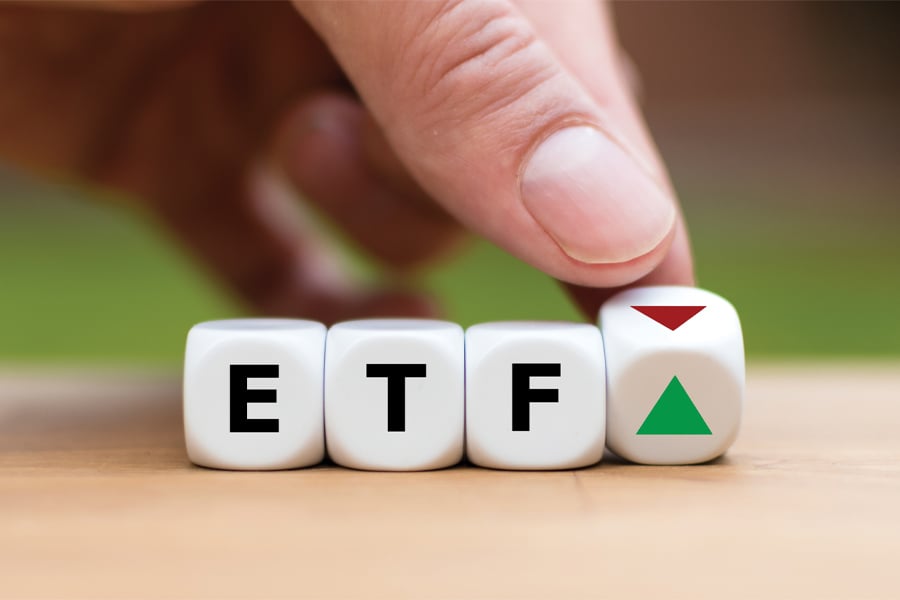

More than half of financial advisors now say they prefer ETFs over mutual funds if the same strategies are available from their favorite asset managers.
Chalk it up to exchange-traded funds’ lower costs, tax efficiency and slightly higher liquidity.
A report Monday from ISS found that 57% of advisors are partial to ETFs, up from 49% who said the same two years ago. The growth in uptake by advisors comes as more fund providers offer products in an ETF structure, including actively managed strategies.
While 57% of advisors said they prefer ETFs, 23% said they opt for separately managed accounts and 20% said they go with open-end mutual funds. But advisors’ preferences varied significantly, with 79% of RIAs citing ETF preferences, compared with 54% of those at regional, independent and bank channels, and 50% of those at broker-dealers, according to the report.
Change within model portfolios has been rapid. Over the past two years, the average percentage of assets advisors have invested in ETFs in their model portfolios has increased from 18% to 26%, data published earlier this year by Fidelity show.
Meanwhile, 91% of advisors allocate some assets to ETFs, compared with 94% who use mutual funds, according to a Cogent Syndicated report in August by Escalent. Among those who use ETFs, nearly half, 48% said they planned to increase their use within client portfolios over the coming year, while 43% said that of mutual funds.
“Like most, [I’ve] been moving away from mutual funds. Some of it is just operational,” said Mark Struthers, founder of Sona Wealth, pointing to higher liquidity and the lack of transaction fees with ETFs. “The trading is easier. I don’t have to worry about a NAV coming low or an assistant not catching it.”
Struthers likes to use Dimensional funds – and that firm earlier this year applied for an ETF share class for its line of mutual funds, which has been an interesting development, he said.
He also leans toward SMAs, predominantly for tax-loss harvesting.
“I hope to integrate them more, but a lot of the time, it’s a pretty big selling process,” Struthers said.
Active ETFs represent the biggest area by far when it comes to product development. This year through July, U.S. fund providers launched 146 active ETFs, compared with 75 index ETFs, 77 active mutual funds and seven index mutual funds, according to ISS. It's also the only product category with significant net growth by the number of funds – as 58 active ETFs were liquidated this year through July, compared with 91 index ETFs, 160 active mutual funds and four index mutual funds.
However, the money has yet to follow. Only 1.3% of U.S. fund assets are in active ETFs, up from 1% in 2021, according to ISS. More than half, 52.4%, are in active mutual funds, followed by 26.2% in index ETFs and 20.1% in index mutual funds.
Across active and passive ETFs, money has been rushing in – at the expense of mutual funds. According to data from Morningstar Direct, $464 billion flowed into ETFs this year through November, compared with $594.5 billion in 2022 and $910.6 billion in 2021. Money flowed out of open-end mutual funds this year through November to the tune of $431.3 billion, compared with net outflows of $960.9 billion in 2022 and net inflows of $304.8 billion in 2021.
Nonetheless, considerably more money is still invested in mutual funds, which represented $17.7 trillion as of the end of November, compared with $7.7 trillion in ETFs, the data show.

Firms announce new recruits including wirehouse breakaways.

"QuantumRisk, by design, recognizes that these so-called "impossible" events actually happen, and it accounts for them in a way that advisors can see and plan for," Dr. Ron Piccinini told InvestmentNews.

Advisors who invest time and energy on vital projects for their practice could still be missing growth opportunities – unless they get serious about client-facing activities.

The policy research institution calculates thousands in tax cuts for Washington, Wyoming, and Massachusetts residents on average, with milder reductions for those dwelling in wealth hotspots.

Yieldstreet real estate funds turned out to be far riskier than some clients believed them to be, according to CNBC.
Orion's Tom Wilson on delivering coordinated, high-touch service in a world where returns alone no longer set you apart.
Barely a decade old, registered index-linked annuities have quickly surged in popularity, thanks to their unique blend of protection and growth potential—an appealing option for investors looking to chart a steadier course through today's choppy market waters, says Myles Lambert, Brighthouse Financial.
